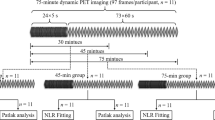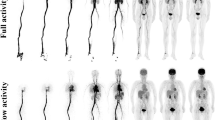Abstract
Purpose
To investigate the kinetic metrics of 2-[18F]-fluoro-2-deoxy-d-glucose (18F-FDG) in normal organs by using dynamic total-body (TB) positron emission tomography (PET).
Methods
Dynamic TB-PET was performed for nine healthy volunteers. Time-to-activity curves (TACs) were obtained by drawing regions of interest in the organs. A two-tissue compartment model was fitted for each tissue TAC. Constant rates, including k1, k2, and k3, and the metabolic rate of FDG (MRFDG) were obtained. The parameter statistics, including the average, standard deviation, coefficient of variance, and inter-site and inter-individual variances, were compared.
Results
Constant rates and MRFDG varied significantly among organs and subjects, but not among sides or sub-regions within an organ. The mean k1 and k2 ranged from 0.0158 min−1 in the right lower lung to 1.1883 min−1 in the anterior wall of the left ventricle (LV) myocardium and from 0.1116 min−1 in the left parietal white matter to 4.6272 min−1 in the left thyroid, respectively. The k3 was lowest in the right upper area of the liver and highest in the septal wall of the LV myocardium. Mean MRFDG ranged from 23.1696 μmol/100 g/min in the parietal cortex to 0.5945 μmol/100 g/min in the lung. Four groups of organs with similar kinetic characteristics were identified: (1) the cerebral white matter, lung, liver, muscle, bone, and bone marrow; (2) cerebral and cerebellar cortex; (3) LV myocardium and thyroid; and (4) pancreas, spleen, and kidney.
Conclusion
The kinetic rates and MRFDG significantly differed among organs. The kinetic metrics of FDG parameters in normal organs can serve as a reference for future dynamic PET imaging and research.






Similar content being viewed by others
Data availability
The datasets used and/or analyzed in the current study are available from the corresponding author on reasonable request.
References
Zhang X, Xie Z, Berg E, Judenhofer MS, Liu W, Xu T, et al. Total-body dynamic reconstruction and parametric imaging on the uEXPLORER. J Nucl Med. 2020;61(2):285–91.
Cherry SR. In vivo molecular and genomic imaging: new challenges for imaging physics. Phys Med Biol. 2004;49(3):R13–48.
Rahmim A, Lodge MA, Karakatsanis NA, Panin VY, Zhou Y, McMillan A, et al. Dynamic whole-body PET imaging: principles, potentials and applications. Eur J Nucl Med Mol Imaging. 2019;46(2):501–18.
Cheng G, Alavi A, Lim E, Werner TJ, Del Bello CV, Akers SR. Dynamic changes of FDG uptake and clearance in normal tissues. Mol Imaging Biol. 2013;15(3):345–52.
Fujimura Y, Kimura Y, Simeon FG, Dickstein LP, Pike VW, Innis RB, et al. Biodistribution and radiation dosimetry in humans of a new PET ligand, 18F-PBR06, to image translocator protein (18 kDa). J Nucl Med. 2010;51(1):145–9.
Badawi RD, Shi H, Hu P, Chen S, Xu T, Price PM, et al. First human imaging studies with the EXPLORER total-body PET scanner. J Nucl Med. 2019;60(3):299–303.
Zhang X, Badawi RD, Cherry SR, Qi J. Theoretical study of the benefit of long axial field-of-view PET on region of interest quantification. Phys Med Biol. 2018;63(13):767–70.
Cherry SR, Badawi RD, Karp JS, Moses WW, Price P, Jones T. Total-body imaging: transforming the role of positron emission tomography. Sci Transl Med. 2017;9(381):eaaf6169.
Surti S, Karp JS. Impact of detector design on imaging performance of a long axial field-of-view, whole-body PET scanner. Phys Med Biol. 2015;60(13):5343–58.
Cherry SR, Jones T, Karp JS, Qi J, Moses WW, Badawi RD. Total-Body PET: Maximizing sensitivity to create new opportunities for clinical research and patient care. J Nucl Med. 2018;59(1):3–12.
Heiss W, Pawlik G, Herholz K, Wagner R, Goldner H, Wienhard K. Regional kinetic constants and cerebral metabolic rate for glucose in normal human volunteers determined by dynamic positron emission tomography of [1Sp]-2-pluoro-2-deoxy-n-glucose. J Cereb Blood Flow Metab. 1984;4(2):212–23.
Morita K, Katoh C, Yoshinaga K, Noriyasu K, Mabuchi M, Tsukamoto T, et al. Quantitative analysis of myocardial glucose utilization in patients with left ventricular dysfunction by means of 18F-FDG dynamic positron tomography and three-compartment analysis. Eur J Nucl Med Mol Imaging. 2005;32(7):806–12.
Choi Y, Brunken RC, Hawkins RA, Huang SC, Buxton DB, Hoh CK, et al. Factors affecting myocardial 2-[F-18]fluoro-2-deoxy-D-glucose uptake in positron emission tomography studies of normal humans. Eur J Nucl Med. 1993;20(4):308–18.
Brix G, Ziegler SI, Bellemann ME, Doll J, Schosser R, Lucht R, et al. Quantification of [(18)F]FDG uptake in the normal liver using dynamic PET: impact and modeling of the dual hepatic blood supply. J Nucl Med. 2001;42(8):1265–73.
Choi Y, Hawkins RA, Huang SC, Brunken RC, Hoh CK, Messa C, et al. Evaluation of the effect of glucose ingestion and kinetic model configurations of FDG in the normal liver. J Nucl Med. 1994;35(5):818–23.
Hays MT, Segall GM. A mathematical model for the distribution of fluorodeoxyglucose in humans. J Nucl Med. 1999;40(8):1358–66.
Yokoyama I, Inoue Y, Moritan T, Ohtomo K, Nagai R. Measurement of skeletal muscle glucose utilization by dynamic 18F-FDG PET without arterial blood sampling. Nucl Med Commun. 2005;26(1):31–7.
Boellaard R, Delgado-Bolton R, Oyen WJ, Giammarile F, Tatsch K, Eschner W, et al. FDG PET/CT: EANM procedure guidelines for tumour imaging: version 2.0. Eur J Nucl Med Mol Imaging. 2015;42(2):328–54.
Wahl LM, Asselin MC, Nahmias C. Regions of interest in the venous sinuses as input functions for quantitative PET. J Nucl Med. 1999;40(10):1666–75.
Wu H, Dimitrakopoulou-Strauss A, Heichel TO, Lehner B, Bernd L, Ewerbeck V, et al. Quantitative evaluation of skeletal tumours with dynamic FDG PET: SUV in comparison to Patlak analysis. Eur J Nucl Med. 2001;28(6):704–10.
Price PM, Badawi RD, Cherry SR, Jones T. Ultra staging to unmask the prescribing of adjuvant therapy in cancer patients: the future opportunity to image micrometastases using total-body 18F-FDG PET scanning. J Nucl Med. 2014;55(4):696–7.
de Geus-Oei LF, Visser EP, Krabbe PF, van Hoorn BA, Koenders EB, Willemsen AT, et al. Comparison of image-derived and arterial input functions for estimating the rate of glucose metabolism in therapy-monitoring 18F-FDG PET studies. J Nucl Med. 2006;47(6):945–9.
Keiding S, Munk OL, Schiøtt KM, Hansen SB. Dynamic 2-[18F]fluoro-2-deoxy-d-glucose positron emission tomography of liver tumours without blood sampling. Eur J Nucl Med. 2000;27(4):407–12.
Huang SC, Phelps ME, Hoffman EJ, Sideris K, Selin CJ, Kuhl DE. Noninvasive determination of local cerebral metabolic rate of glucose in man. Am J Phys. 1980;238(1):E69–82.
Laffon E, Adhoute X, de Clermont H, Marthan R. Is liver SUV stable over time in (1)(8)F-FDG PET imaging? J Nucl Med Technol. 2011;39(4):258–63.
Wahl RL, Jacene H, Kasamon Y, Lodge MA. From RECIST to PERCIST: evolving considerations for PET response criteria in solid tumors. J Nucl Med. 2009;50(Suppl 1):122S–50S.
Code availability
Not applicable
Funding
This study was funded by the Shanghai “Rising Stars of Medical Talent”—Youth Development Program (grant number: HWJRS2019-72), the Training Program for Excellent Young Medical Talents of Zhongshan Hospital of Fudan University (grant number: 2019ZSYQ28), the Shanghai Municipal Key Clinical Specialty Project (grant number: shslczdzk03401), the Major Science and Technology Projects for Major New Drug Creation (2019ZX09302001), the National Key Research and Development Program of China (grant number: 2016YFC0103908), the Three-year Action Plan of Clinical Skills and Innovation of Shanghai Hospital Development Center (grant number: SHDC2020CR3079B), and the Shanghai Science and Technology Committe (grant number: 20DZ2201800).
Author information
Authors and Affiliations
Contributions
G.L. and H.S. had full access to all the data in the study and take responsibility for the integrity of the data and the accuracy of the data analysis. G.L., X.L., and H.S. were responsible for the concept and design of the study. G.L., P.H., Y.Z., and H.T. were involved in data acquisition. G.L., H.X., X.L., and H.S. were involved in data analysis and interpretation. G.L. and H.S. drafted the manuscript, and all authors revised it critically. G.L. and H.X. performed the statistical analysis. G.L. and H.S. obtained funding. X.L. and H.S. supervised the study.
Corresponding authors
Ethics declarations
Conflict of interest
The authors declare that they have no conflict of interest.
Ethics approval
This study was approved by the Ethics Committee of Zhongshan Hospital of Fudan University (approval number: IRB2015-098). Written informed consent was obtained from all participants.
Consent to participate
Written informed consent was obtained from the included patients for participation in this study.
Consent for publication
The authors affirm that the human research participants provided informed consent for the publication of the studied data and the images in Fig. 1.
Additional information
Publisher’s note
Springer Nature remains neutral with regard to jurisdictional claims in published maps and institutional affiliations.
This article is part of the Topical Collection on Radiopharmacy
Supplementary information
ESM 1
(DOCX 456 kb)
Rights and permissions
About this article
Cite this article
Liu, G., Xu, H., Hu, P. et al. Kinetic metrics of 18F-FDG in normal human organs identified by systematic dynamic total-body positron emission tomography. Eur J Nucl Med Mol Imaging 48, 2363–2372 (2021). https://doi.org/10.1007/s00259-020-05124-y
Received:
Accepted:
Published:
Issue Date:
DOI: https://doi.org/10.1007/s00259-020-05124-y




